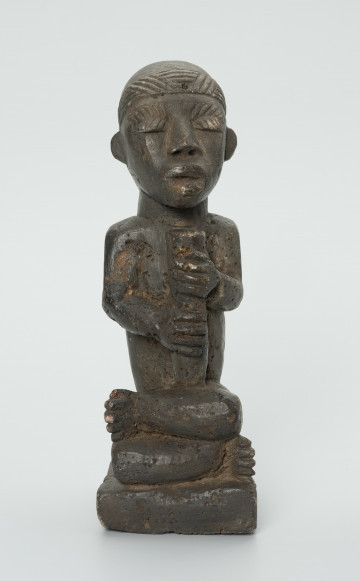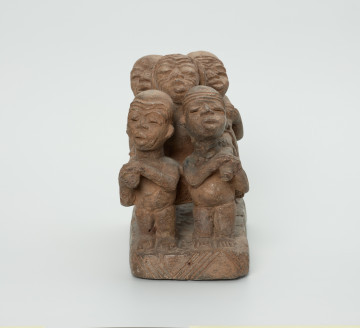
Ancestor worship figure
około 1901 — 2000
National Museum in Szczecin
Part of the collection: Mintadi figurines
Mintadi (singular ntadi) are sculptures associated with ancestor worship and the cult of the dead. They were most often found in cemeteries as grave figures of high-rank chiefs. They are associated with the tradition and culture of the Kingdom of the Congo established in the 14th century in the lower reaches of the Congo River (present-day territories of northern Angola, the Republic of the Congo, the western part of the Democratic Republic of the Congo).Among mintadi, there are mainly representations of dignitaries and rulers, who can be recognised by the insignia of power, including a pipe, a staff, a cap or a drum. On the other hand, dignitaries and notables of lower ranks are depicted in an attitude expressing respect and submission. The sculpture in question shows a kneeling man hitting a slit drum with sticks. The drum in Bakongo culture is considered one of the signs of royal power. In the Kingdom of the Congo, drums were used, among other things, during the enthronement ceremony of the new mani, i.e., the head of the province, also known as the image of the king, that needed chiefs because his real power did not reach beyond the borders of the central area. According to an account by Father Lorenzo da Lucca in 1636, the enthronement ceremony of the new mani and his spouse took place in the province of Sojo. An essential part of the event was when the enthroned couple leaned against two wooden drums as symbols of their power. The mani touched the larger drum, while his spouse touched the smaller one. Both looked as if they were in a state of prayer, reverie. It was believed that from the moment of the ceremony, the drum was linked to the mani, and thereby, any damage to the drum would threaten the health and life of the new ruler.
Katarzyna Findlik-Gawron
Author / creator
Dimensions
cały obiekt: height: 22,7 cm, width: 9,6 cm
Object type
sculpture
Creation time / dating
Creation / finding place
Identification number
Location / status

około 1901 — 2000
National Museum in Szczecin

około 1901 — 2000
National Museum in Szczecin

około 1901 — 2000
National Museum in Szczecin
DISCOVER this TOPIC
Museum of King Jan III's Palace at Wilanów
DISCOVER this PATH
Educational path